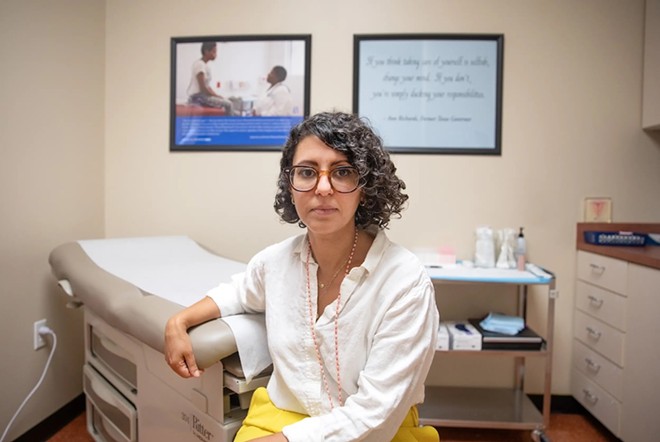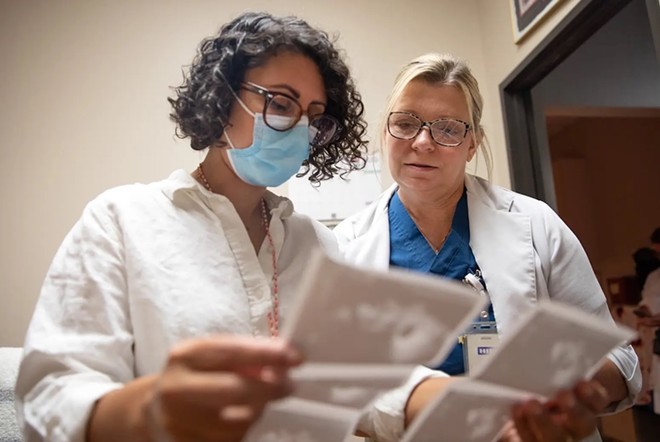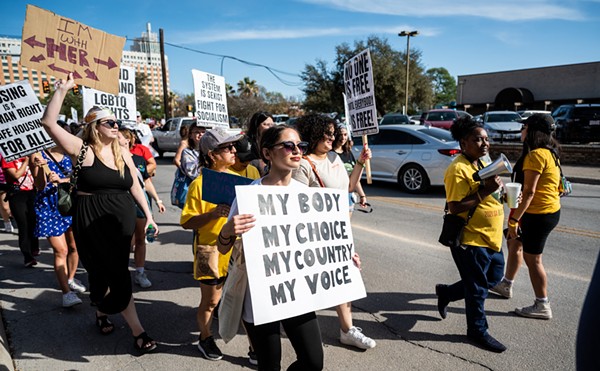
Texas restricted and then banned abortion. The state removed Planned Parenthood affiliates from state-funded health programs and turned down federal dollars rather than allow Planned Parenthood to receive them. Planned Parenthood has been cut out of funding for cancer screenings, contraception, HIV prevention and sex education.
Despite this concerted effort from the highest levels of state government, Planned Parenthood’s clinic doors have remained open in Texas.
“My mantra is, every day that I show up to the clinic, I’m winning,” said Dr. Amna Dermish, the chief operating and medical services officer at Planned Parenthood of Greater Texas.
But now, the organization is facing a potentially existential threat from its longtime tormentor.
Last year, the state filed a federal lawsuit claiming Planned Parenthood improperly billed Medicaid for $10 million in payments during the period when the state was trying to remove the organization from the program.
Texas is seeking more than $1.8 billion in reimbursement, penalties and fees.
Planned Parenthood has called the lawsuit meritless, pointing out that there was an injunction in place that allowed it to continue to bill Medicaid during that time.
U.S. District Judge Matthew Kacsmaryk, a conservative who previously worked on anti-abortion cases as a religious liberty lawyer, will hear arguments from both sides today in Amarillo.
“We have weathered a lot of storms, but we’ve always been able to come through and be there for our patients,” Dermish said. “That ultimately is why I come to work every single day, and it’s just my biggest fear if one day we’re not able to do that.”
Early efforts to defund Planned Parenthood
At the dawn of the 2010s, a long-simmering tension between conservative states and Planned Parenthood reached a full boil.
It was Planned Parenthood’s work as an abortion provider that put a target on its back. But because, typically, state or federal funds can’t be used to fund abortion services, red states have had to find other ways to starve Planned Parenthood of its resources.
Texas, as is its style, led the way. In 2011, legislators eviscerated the state’s family planning budget from $111 million to $38 million and directed the remaining money to be distributed first to public agencies, like county health departments, and primary care centers. Specialized family planning organizations like Planned Parenthood could access this funding only if there was no one else willing to offer contraception and family planning services in the area.
As a result of these funding cuts, 82 clinics — 25% of publicly funded clinics statewide — closed or stopped providing family planning services. Clinics that remained open scaled back their hours and services, especially when it came to more expensive and time-intensive contraception methods like IUDs, sterilization and vasectomies.
Most of the clinics that closed were not affiliated with Planned Parenthood. But at the same time, legislators tried to remove Planned Parenthood from the Women’s Health Program, another funding stream that helped low-income women access contraception. This program was primarily funded by the federal government, which paid $9 for every $1 that Texas kicked in.
The Obama administration told Texas it couldn’t exclude a qualified health care provider from the program; the courts agreed, as they did in every case concerning a state’s effort to cut Planned Parenthood out of federal funds.
But then, Texas did something no other state had tried yet: It walked away from about $30 million in annual federal funds rather than allow Planned Parenthood to continue to provide contraception to low-income women. In 2013, Texas launched its own women’s health program, relying entirely on state dollars.
Texas’ reproductive health care landscape never recovered from this tornado, even when the state tried to make up the lost funding in future sessions.
“Because they had decimated a network that had taken decades to build, if they wanted to actually effectively fix that problem, they would have had to devote even more resources in a dedicated way,” said Amanda Stevenson, a sociologist at the University of Colorado who studied these changes. “Once you close a clinic, getting it open again is way more expensive than just staying open.”
This was just the beginning: In 2015, legislators removed Planned Parenthood from the Breast and Cervical Cancer Services program, which provides cancer screenings to low-income women, and cut off funding for one affiliate’s long-standing HIV prevention program.
“Every time the state cuts these programs in an attempt to score political points ... the true victims here are tens of thousands of women and men who no longer have access to health care that they need,” Rochelle Tafolla, a spokesperson for Planned Parenthood Gulf Coast, told the Texas Tribune at the time.
Removing Planned Parenthood from Medicaid
Just as the dust was beginning to settle on these huge changes to the family planning program, Texas opened a new line of attack on Planned Parenthood. The impetus was videos secretly recorded by anti-abortion activists that claimed to show Planned Parenthood employees in California discussing the illegal sale of fetal remains.
Planned Parenthood vehemently denied the claims, saying the videos were doctored and instead reflected conversations about the legal donation of fetal tissue for research purposes.
The same activists also visited a Planned Parenthood in Houston, and Attorney General Ken Paxton said at the time he had obtained “hours of recordings”detailing how the clinic handled fetal remains.
Twelve states, including Texas, and Congress investigated the claims; a grand jury in Texas found no evidence of wrongdoing by Planned Parenthood — and, instead, indicted the anti-abortion activists for their deceptive methods. (The charges were later dismissed.)
But Texas used the public outrage around these videos to try to finally remove Planned Parenthood from the Medicaid program once and for all. At the time, Planned Parenthood clinics in Texas received about $3.1 million a year in Medicaid funding to provide family planning and primary care to low-income Texans.
As one of just 12 states that has not expanded the program, Medicaid in Texas essentially provides health insurance coverage only for children, pregnant women, disabled adults and the poorest residents.
“These are very vulnerable patients,” said Laura Thomas, vice president of patient care at Planned Parenthood Gulf Coast. “And a lot of practices don’t take Medicaid, or they have a long waitlist or maybe the facility isn’t accessible … so it felt really important that we keep being able to provide this.”
In 2016, Texas Health and Human Services Inspector General Stuart Bowen issued a final notice to Planned Parenthood, saying the undercover videos showed the organization acting in a way that “violate[s] generally accepted medical standards, as reflected in state and federal law, and are Medicaid program violations that justify termination.”
Planned Parenthood sued, kicking off a yearslong legal battle to determine whether Texas had the right to remove a provider from the joint state-federal program. In 2017, a judge granted an injunction that allowed Planned Parenthood to continue to treat patients and bill Medicaid while this question moved through the courts.
During this time, Planned Parenthood affiliates in Texas continued to provide birth control, cancer screenings, HIV tests and other medical services to patients on Medicaid, it continued to bill the state for those services and it continued to be reimbursed.
Finally, in March 2021, the final ruling came down, allowing Texas to remove Planned Parenthood from the Medicaid program.
“That was one of the hardest days of my career,” Thomas said. “These were patients we’d been treating for a long time, who came to us for a lot, and we were just very worried about where they were going to go.”
With several rounds of funding and program cuts under their belt, the providers at Planned Parenthood knew there wasn’t a robust system of medical practices that accepted Medicaid waiting to catch these new patients.
“The assumption that patients will simply obtain their health care elsewhere is simply not true,” said Laura Terrill, the president at Planned Parenthood South Texas. “We’ve seen STI rates increase, maternal mortality rates increase, teen pregnancy increase … after health centers were forced to close.”
The clinics did what they could, making medical records available for transfer, preparing lists of possible providers and fundraising to provide low-cost private pay options. While this was happening, the state implemented a new abortion law that prohibited the procedure after about six weeks of pregnancy. Planned Parenthood, like all abortion clinics in Texas, complied.
“This was a time when we should be encouraging additional people to come into the health care network, and instead, there was a concerted effort to kick critically important providers out of the network,” Terrill said.
And then came the lawsuit. Texas and an anonymous filer, claiming to be associated with the group that released the videos back in 2015, claim Planned Parenthood should have to pay back all the Medicaid reimbursements it received while the injunction was in place.
The 2022 lawsuit, filed by Paxton before he was impeached this year, argues that Planned Parenthood erred by not appealing the initial termination through administrative channels and instead pursuing the case through the courts.
Though they’re seeking to claw back $10 million in payments, they’ve asked the judge to order Planned Parenthood to pay an additional two times that value, plus civil penalties and interest from the day the payment was billed as well as expenses, costs and attorneys fees.
The estimated $1.8 billion payment would likely bankrupt Texas’ three Planned Parenthood affiliates several times over at a moment the organization argues they are needed more than ever.
“We have a high uninsured and underinsured rate in Texas,” Dermish said. “We have an epidemic of syphilis. We have no access to prenatal care. I don’t see anybody rushing to fill that void, and in the aftermath of [Dobbs v. Jackson Women’s Health Organization], there’s been no effort to truly expand access to care. It’s just so frustrating.”
Thomas said one of the most painful parts of this lawsuit is the implication that the organization, knowing how dedicated Texas is to shutting it down, failed to follow proper administrative procedure.
“Our organization knows we always have to be making decisions that are the most ethical and the most compliant with any rule or regulation out there, so it just felt like a great injustice,” she said. “I had hoped that if you play by the rules and do the right thing, it will turn out right, but that’s not the case.”
Before President Donald Trump appointed him to the bench, Kacsmaryk worked for First Liberty Institute, a conservative religious liberty firm based in Plano. He litigated several anti-abortion casesand has espoused personal animustoward abortion.
In April, Kacsmaryk suspended approval of mifepristone, a common abortion-inducing drug. The U.S. Supreme Court put that ruling on holdtemporarily. He also ruled that Title X, a long-standing federal program that provides confidential contraception to anyone, including minors, violated Texas parents’ rights.
Planned Parenthood has called this lawsuit meritless and asked Kacsmaryk to dismiss it entirely. But Texas and the anonymous plaintiff recently filed a briefclaiming a June Supreme Court decision about the False Claims Act clarified the law in their favor.
Kacsmaryk is scheduled to hear arguments from both sides today. He has not said when he will rule.
Disclosure: Planned Parenthood has been a financial supporter of The Texas Tribune, a nonprofit, nonpartisan news organization that is funded in part by donations from members, foundations and corporate sponsors. Financial supporters play no role in the Tribune's journalism. Find a complete list of them here.
This article originally appeared in the Texas Tribune.The Texas Tribune is a member-supported, nonpartisan newsroom informing and engaging Texans on state politics and policy. Learn more at texastribune.org.
Subscribe to SA Current newsletters.
Follow us: Apple News | Google News | NewsBreak | Reddit | Instagram | Facebook | Twitter| Or sign up for our RSS Feed

















